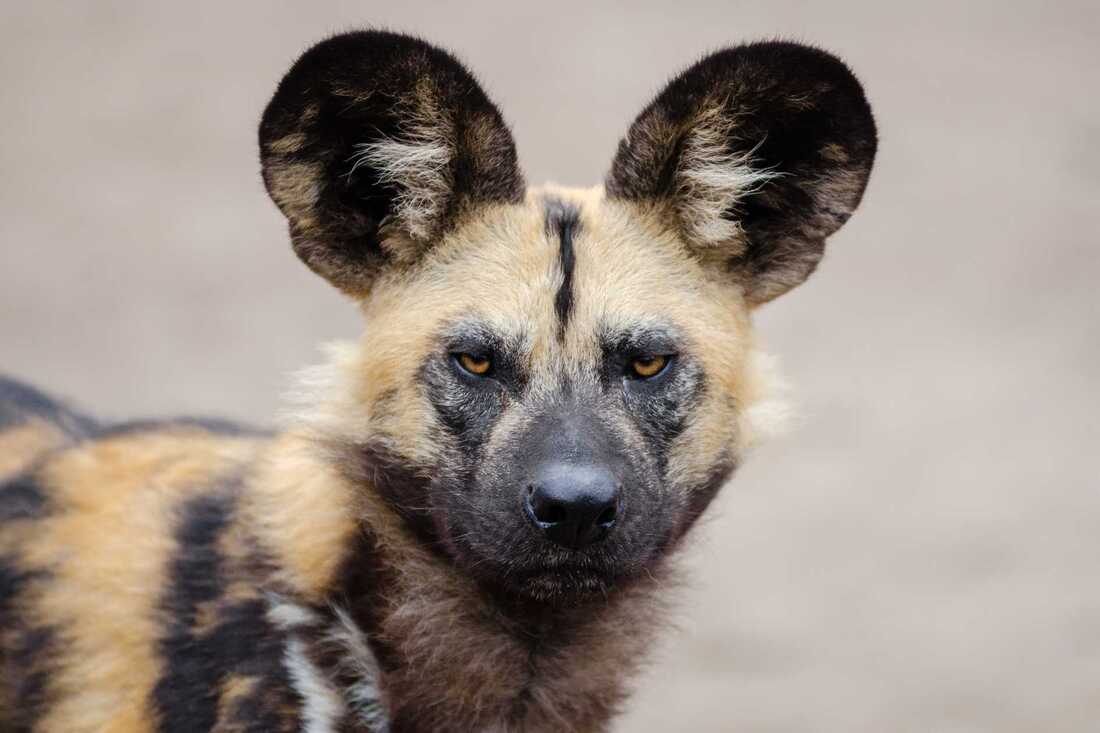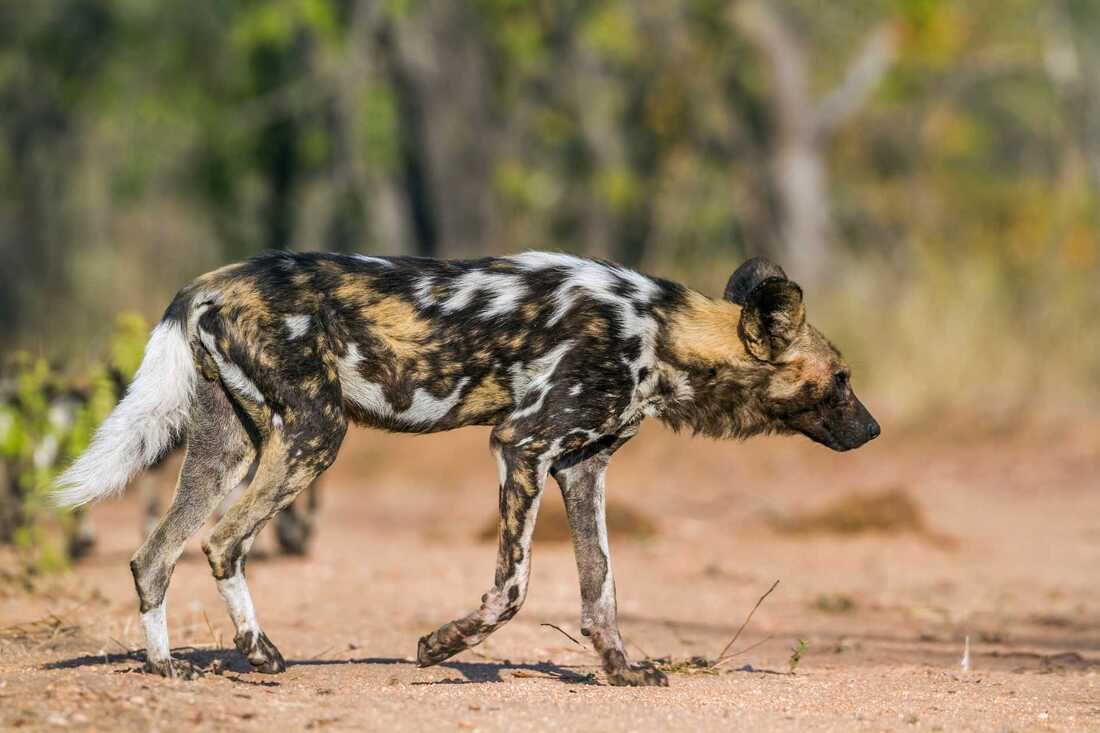|
The African wild dog, scientifically known as Lycaon pictus, is an enigmatic and captivating creature native to the vast savannahs and woodlands of sub-Saharan Africa. Also called painted dogs or African hunting dogs, they are among the continent's most intriguing wildlife species. One of the most striking features of African wild dogs is their distinctive coat pattern, resembling a work of art crafted by nature herself. Each individual sports a unique arrangement of black, brown, yellow, and white patches; complex patterns as unique as fingerprints, enabling personal recognition within the pack. It is also believed that their unique patterning may play a role in temperature regulation, aiding them in the harsh African climate. In East and Northeast Africa, painted dogs are known to have darker patterns than those of their Southern African counterparts. With ears that Mickey Mouse himself would be proud of - often compared to satellite dishes - the African wild dog’s keen sense of hearing is invaluable during hunts. Their remarkably large and rounded ears serve as excellent tools for hearing distant sounds, even detecting the faintest rustling of potential prey in the tall grasses. Their distinctive, usually white-tipped bushy tails aid in maintaining balance during high-speed chases, which are characteristic of their hunting strategy. Pack Mentality: Social Structure and Cooperation African wild dogs are incredibly social animals, living in packs that consist of 6 to 20 individuals, although much larger packs have been observed in rare cases. Within the pack, African wild dogs exhibit a strong sense of cooperation and hierarchy. The pack structure is led by an alpha breeding pair, typically the only members that reproduce, while the others help care for and protect the pups. This cooperative structure extends to hunting, where the dogs work as a team to secure their prey. Painted Predators: Hunting and Efficiency African wild dogs are renowned for their remarkable hunting prowess. They are among the most efficient predators in the animal kingdom, boasting an astonishing hunting success rate of up to 80%, far surpassing that of lions and other big cats. Their success is attributed to teamwork, strategy, and incredible stamina. When hunting, the pack first identifies a target and chases it relentlessly, often covering vast distances at high speeds, sometimes reaching up to 37 mph (60 km/h). Their stamina allows them to keep up the chase until their prey becomes exhausted. Once caught, the dogs quickly dispatch their quarry with precision bites, usually avoiding any unnecessary harm to themselves. Conservation Challenges Despite their remarkable adaptations and hunting abilities, African wild dogs face numerous threats to their survival. Habitat loss due to human encroachment, disease transmission from domestic dogs, and direct persecution pose significant risks to their populations. Today, African wild dogs are listed as endangered by the International Union for Conservation of Nature (IUCN), with fewer than 6,500 individuals estimated to remain in the wild. Conservation efforts are vital to ensuring the survival of these incredible animals. Initiatives focus on protecting their natural habitat, raising awareness, and mitigating human-wildlife conflicts. Captive breeding and reintroduction programs also play a crucial role in boosting their numbers and genetic diversity. Painted Dog Conservation Progress in Zimbabwe At the end of August, we celebrated World Painted Dog Day, in recognition of one of the most fascinating and least understood animals in Africa, the African Painted (or Wild) Dog. Also now known as the Painted Wolf since an attempted rebranding, of good but misguided intent in my opinion, to make them sound more appealing. Call them what you like, I have been fascinated by them since I first saw one in Botswana in 2004, and have been a supporter of Painted Dog Conservation in Zimbabwe for two decades. Painted Dog Conservation (PDC) has been operating in the buffer zone outside Hwange National Park (HNP), Zimbabwe, for more than 25 years. During this time, they had only ever monitored two packs in the area, and sometimes none! In 2007, for example, they did not see a single painted dog outside HNP. Over the years, they have maintained a consistent anti-poaching presence and, in 2014 significantly increased this effort with the help of the Mabale Community Anti-Poaching teams. This direct-action strategy has been backed up, over the same period, by a world class education and awareness programme, and now we are seeing the fruits of their labour. For the first time in over 25 years, they have recorded five packs of painted dogs utilising the buffer zone on the edge of HNP: namely the Mpindothela pack, Bachijwa pack, the Kingsbury pack, the Umkhonto pack, and the Thutshu pack, which has been traced all the way from Botswana. The Kingsbury pack is the most recent pack of painted dogs that has emerged in the buffer zone outside HNP. This pack illustrates the critical importance of long-term monitoring in understanding the demography of the HNP painted dog population. The pack consists of dispersals from the Spectrum pack, which has been monitored for more than six years, and two other dogs no record. It's incredibly rewarding to witness the increasing number of packs utilising the buffer zone, and this growth is a positive sign that the environment is becoming more attractive and conducive for wildlife once again, while also pointing to an increasing and stable population of Painted dogs in HNP. This achievement serves as a testament to the effectiveness of the work PDC does with generous support and that of collaborative partners and authorities. Together, we are creating an environment where painted dogs can thrive, ensuring a brighter future for these incredible animals. As work continue on the conservation frontline, celebrating this success, one should be conscious of how easily and quickly this can all be undone. The Anti-poaching and Education programmes are labour intensive, vehicle-reliant and increasingly expensive to run, with internationally high fuel and commodity prices. Without continued generous financial support, they will have to make cutbacks that will impact negatively on their work and quite probably lead to a decline in the flourishing Painted dog population. A donation today will not only help maintain but also increase efforts to keep on this progressive conservation trajectory. African wild dogs are a testament to the wonders of nature. Their stunning appearance, complex social structures, and unrivalled hunting abilities make them one of the most intriguing species on the African continent. However, they are also one of the most endangered, facing numerous challenges in the modern world.
By understanding and appreciating the uniqueness of African wild dogs, we can foster greater awareness and support for their conservation. Their survival depends on our collective efforts to protect their habitats and ensure that these "painted predators" continue to roam the African savannah for generations to come. A few of the destinations where you may be lucky enough to experience a sighting of these incredible hunters include Madikwe Game Reserve, Hluhluwe-Imfolozi Game Reserve, Manyoni Game Reserve, and the Greater Kruger, all in South Africa, South Luangwa National Park - Zambia, Mana Pools - Zimbabwe, Okavango Delta, Linyanti & Savuti - Botswana, Laikipia - Kenya, Ruaha, and Nyerere National Park - Tanzania.
0 Comments
Leave a Reply. |
AuthorPhotographer, conservationist, dive and field guide, teller of bad jokes. Archives
July 2024
Categories
All
|
-
Safari & Beach
-
Diving & Snorkelling
-
Africa and the Indian Ocean
>
-
Caribbean & Americas
>
-
Indonesia
>
- Bali >
- Komodo National Park >
- West Papua and Raja Ampat >
- Lembeh >
- Bangka Island >
- Siladen Island >
- Manado >
-
Indonesia Liveaboards
>
- Raja Ampat Aggressor
- Emperor Raja Laut
- Ondina Liveaboard
- Sea Safari 8
- Sea Safari VI
- Sea Safari VII
- Cheng Ho
- Amira Liveaboard
- Indo Aggressor
- Tambora Liveaboard
- Seahorse Liveaboard
- Adelaar Liveaboard
- Damai I Liveaboard
- Damai II Liveaboard
- Tarata Liveaboard
- Ambai Liveaboard
- Gaia Love
- Putri Papua
- Indo Siren Liveaboard
- TemuKira Liveaboard
- Solitude Adventurer
- Pearl of Papua
- Seven Seas
- Pindito Liveaboard
- Mermaid I Liveaboard
- Mermaid II Liveaboard
- Dewi Nusantara
- Coralia liveaboard
- Blue Manta
- True North
-
Oceania and The South Pacific
>
-
South East Asia
>
-
Africa and the Indian Ocean
>
-
Specials & Faves
- Safari & Beach Specials
- Solo Safari Specials
- Family Safari Specials
- Dive Specials
- 03 July - Stormers vs British & Irish Rugby, Cape Town
- 07 July - SA Invitational vs British & Irish Rugby, Port Elizabeth
- 10 July - Sharks vs British & Irish Rugby, Durban
- 14 July - South Africa 'A' vs British & Irish Rugby, Nelspruit
- 17 July - Bulls vs British & Irish Rugby, Pretoria
- 24 July - South Africa vs British & Irish Rugby, Soweto
- 31 July - South Africa vs British & Irish Rugby, Cape Town
- 07 August - Springboks vs British & Irish Rugby, Johannesburg
- Contact Us
- Why Book With Us?
- Testimonials
- Giving back
- Indigoblog
-
Safari & Beach
-
Diving & Snorkelling
-
Africa and the Indian Ocean
>
-
Caribbean & Americas
>
-
Indonesia
>
- Bali >
- Komodo National Park >
- West Papua and Raja Ampat >
- Lembeh >
- Bangka Island >
- Siladen Island >
- Manado >
-
Indonesia Liveaboards
>
- Raja Ampat Aggressor
- Emperor Raja Laut
- Ondina Liveaboard
- Sea Safari 8
- Sea Safari VI
- Sea Safari VII
- Cheng Ho
- Amira Liveaboard
- Indo Aggressor
- Tambora Liveaboard
- Seahorse Liveaboard
- Adelaar Liveaboard
- Damai I Liveaboard
- Damai II Liveaboard
- Tarata Liveaboard
- Ambai Liveaboard
- Gaia Love
- Putri Papua
- Indo Siren Liveaboard
- TemuKira Liveaboard
- Solitude Adventurer
- Pearl of Papua
- Seven Seas
- Pindito Liveaboard
- Mermaid I Liveaboard
- Mermaid II Liveaboard
- Dewi Nusantara
- Coralia liveaboard
- Blue Manta
- True North
-
Oceania and The South Pacific
>
-
South East Asia
>
-
Africa and the Indian Ocean
>
-
Specials & Faves
- Safari & Beach Specials
- Solo Safari Specials
- Family Safari Specials
- Dive Specials
- 03 July - Stormers vs British & Irish Rugby, Cape Town
- 07 July - SA Invitational vs British & Irish Rugby, Port Elizabeth
- 10 July - Sharks vs British & Irish Rugby, Durban
- 14 July - South Africa 'A' vs British & Irish Rugby, Nelspruit
- 17 July - Bulls vs British & Irish Rugby, Pretoria
- 24 July - South Africa vs British & Irish Rugby, Soweto
- 31 July - South Africa vs British & Irish Rugby, Cape Town
- 07 August - Springboks vs British & Irish Rugby, Johannesburg
- Contact Us
- Why Book With Us?
- Testimonials
- Giving back
- Indigoblog






 RSS Feed
RSS Feed


